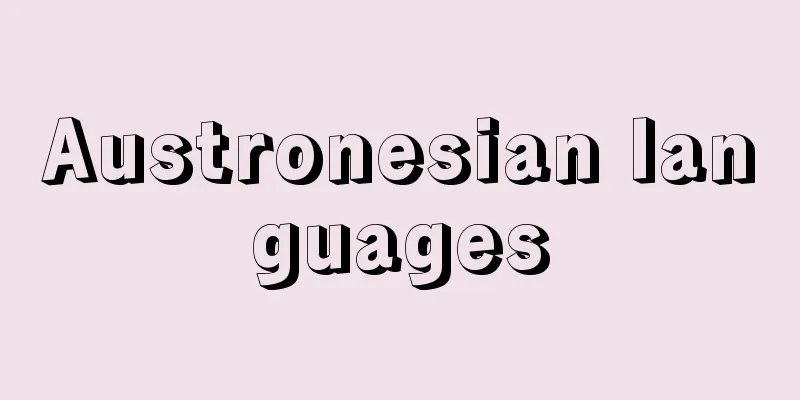Austronesian languages

|
A generic name for the local languages spoken in a wide area, from the Malagasy language of Madagascar (Malagasy Democratic Republic) in the southeast of the African continent in the west to the Rapa Nui language of Easter Island in Chile in South America in the east, the Alpine languages of Taiwan in the north, Hawaiian language in the state of Hawaii in the United States, and Maori language in New Zealand in the south. It is also called the Malayo-Polynesian language family, and there are about 1,000 languages in total. However, the languages of the inland areas of the Malay Peninsula and New Guinea Island, and the languages of the indigenous peoples of Australia, which are included in this area, do not belong to this family, but these are the languages of the indigenous peoples before the migration of the Austronesian peoples. The homeland of the Austronesian people is thought to have been in the southern part of the Asian continent (around present-day Yunnan Province in China), and a group of them had already migrated to Taiwan around 10,000 BC. Over the next several thousand years, the pushed-out peoples spread into the current area. Modern language families are further divided into branches: (1) Hesperonesian, including Malagasy, Malay, Javanese, Tagalog, Cebuano, Chamorro and Palauan of Micronesia; (2) Melanesian, including Biak in eastern Indonesia, the languages of the Bismarck Archipelago, the New Hebrides and New Caledonia, Fijian and most of the languages of Micronesia; and (3) Polynesian, including the eastern languages of the area enclosed by a triangle with Hawaiian, Rapa Nui and Māori at the apex, the Samoic Outer Ring languages such as Samoan, Micronesian Kapingamarangi and Nukuoro, and the Tongik languages including Tongan. The Alpine languages of Taiwan belong to (1), but are sometimes considered to be an independent group due to their archaic phonology and grammar. The only languages with a history as written languages are Javanese and Malay, which have inscriptions in the South Indian Pallava script from the 7th and 8th centuries, and the Melanesian and Polynesian languages have no written traditions. The Easter Island pictograms (Rongorongo) have not yet been successfully deciphered. As for linguistic characteristics, (1) best preserves the proto-Austronesian proto-phonetics and proto-forms, while (2) and (3) show that the number of proto-phonetics changes and decreases, and the proto-forms tend to become open syllabic. Next, we show some of the body vocabulary ('ear', 'chest/milk', 'navel'), all of which have evolved from a single proto-form. Malagasy tadìny, hóho, fòitra Regarding the relationship between Austronesian languages and Japanese, there is a hypothesis that they were involved as a base language of Japanese or as a mixed language, but nothing definitive has been determined. [Sakiyama Osamu] Source: Shogakukan Encyclopedia Nipponica About Encyclopedia Nipponica Information | Legend |
|
西はアフリカ大陸南東洋上のマダガスカル島(マラガシー民主共和国)のマラガシー語から、東は南アメリカのチリ領イースター島のラパヌイ語まで、北は台湾の高山(こうざん)族諸語、アメリカ合衆国ハワイ州のハワイ語から、南はニュージーランドのマオリ語まで広い地域に行われる現地諸言語の系統的総称。マライ・ポリネシア語族(南島語族)ともいわれ、その総数は約1000に達する。ただし、この地域に含まれるマレー半島やニューギニア島の内陸部の言語、オーストラリア先住民の言語などはこの語族に属さないが、これらはオーストロネシア民族が移動してくる以前の先住民族の言語である。オーストロネシア民族のふるさとはアジア大陸南部(現中国の雲南省あたり)にあったと考えられ、紀元前1万年ごろにはその一派がすでに台湾に渡っていた。その後何千年間にもわたって、押し出された民族が現在の地域に広がった。現在の語族はさらに語派に分けられ、(1)ヘスペロネシア語派 マラガシー語、マレー語、ジャワ語、タガログ語、セブ語、ミクロネシアのチャモロ語、パラウ語など、(2)メラネシア語派 インドネシア東部のビアク語、ビスマーク諸島からニュー・ヘブリデス諸島、ニュー・カレドニアの諸言語、フィジー語、ミクロネシアのほとんどの言語、(3)ポリネシア語派 ハワイ語、ラパヌイ語、マオリ語を頂点としてその大三角形に取り囲まれた地域内の東部諸語、サモア語・ミクロネシアのカピンガマランギ語・ヌクオロ語などのサモイック外郭諸語、トンガ語を含むトンギック諸語からなる。 台湾の高山族諸語は(1)に属するが、その音韻的文法的古風さによって独立した一語派とされることもある。書記言語としての歴史をもつのは、7~8世紀から南インド系パッラバ文字による碑文を残したジャワ語、マレー語のみで、メラネシア・ポリネシア諸語に文字の伝承はない。イースター島の絵文字(ロンゴロンゴ)はまだ解読に成功していない。 言語的特徴として、(1)は原オーストロネシア語の祖語音と祖語形をもっともよく保持し、(2)(3)となるにしたがって、祖語音の数は変化して減少し、祖語形は開音節化する傾向が著しい。次に身体語彙(ごい)の一部(「耳」「胸・乳」「へそ」)を示すが、すべて一つの祖語形から変化した形である。 マラガシー語 tadìny, hóho, fòitra オーストロネシア語族と日本語との関係については、日本語の底層言語としてあるいは混合言語として関与したとする仮説があるが、いまだ確定的なことは不明である。 [崎山 理] 出典 小学館 日本大百科全書(ニッポニカ)日本大百科全書(ニッポニカ)について 情報 | 凡例 |
>>: Austrian cuisine - Austrian cuisine
Recommend
Eather, W.
...The premise of most of these theories is that ...
American Finfish - American Finfish
...General term for birds of the Heliornithidae f...
Soffici - Soffici (English spelling) Ardengo Soffici
Italian critic and painter. During his stay in Pa...
Oshiki - Oshiki
A square wooden tray for placing tableware, cups,...
Parachute - Parachute (English spelling)
An umbrella-like device that uses air resistance ...
Abatini, AM - Abatini
…The Roman School's religious music was deeme...
Erkegün (English spelling)
A term used to refer to Christian clergymen, espec...
"Record of the Surrender of Ishiyama"
…The cast includes Kennyo, Kusunoki Masatomo, and...
Yusuke Hagiwara
Astronomer. Pioneer of celestial mechanics in Jap...
Reformed Right-Wing
...After this, many fascist groups were formed, a...
River family tree - River
…the network of rivers found within a drainage ba...
Origin and destination survey
Also called OD survey. A method of traffic survey,...
Serie - Serie (English spelling) French
A musical term. It refers to the twelve-tone sequ...
Hiroshima Bay - Hiroshima Bay
It is an inlet of the Akinada Sea in the western ...
Monochromatic Light
Light that has only a single wavelength or freque...









